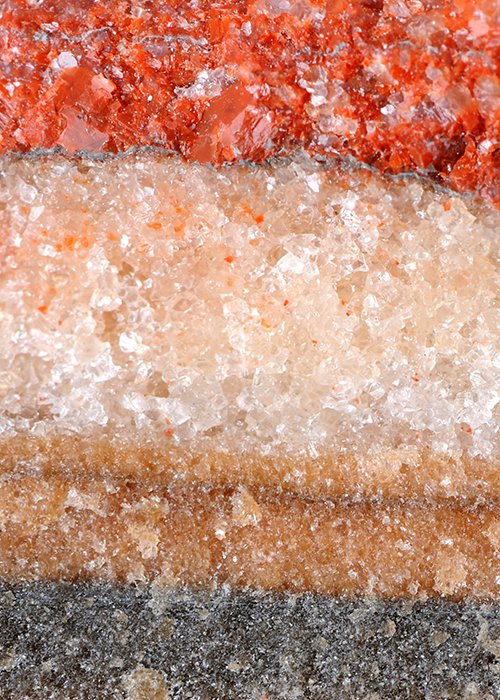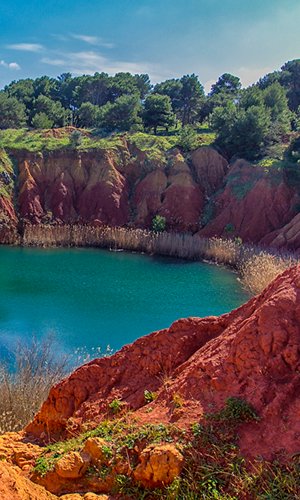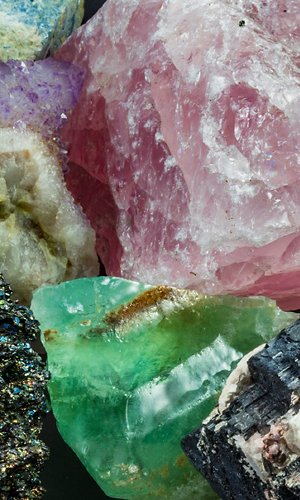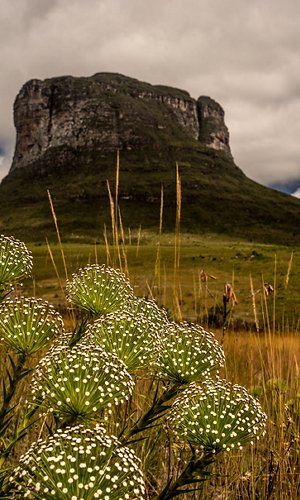The solid part of the Earth is made of rocks that can be collected directly from the Earth’s surface or that can be extracted from mines and by deep drilling both on dry land and on the ocean floors. The rocks can be those forming the mountain we climb up, and can also be formed by deposits created by a large number of fragments, cemented together, that we walk upon every day. Rocks are formed from the combination of a number of minerals, solid substances defined by a precise chemical formula that can be found in nature. Consequently the study and analysis of rocks and minerals is very important because it enables us to define the structure and the composition not only of the Earth’s surface by also what lies inside the Earth.
Voice search

Minerals are solid substances that are present in nature and can be made of one element or more elements combined together (chemical compounds). Gold, Silver and carbon are elements that form minerals on their own. They are called native elements. Instead, ordinary kitchen salt is a chemical compound that is called rock salt, which is a mineral formed of sodium and chlorine ions. Atoms, ions and molecules that form a mineral are present in the space in a tidy way and according to well-defined geometrical shapes, which are called crystal lattices. The structure of the crystal lattice defines the shape of the crystal as we see it. For example, rock salt or kitchen salt is a mineral formed of cubic-shaped crystals. Its crystal lattice has the same shape and consists of sodium and chlorine ions that are present in the space in alternate order.
The order of atoms in the space and the way they combine with each other determine the way a mineral can laminate or exfoliate. Lamination is the property that some materials have to break according to their geometrical shape. Its chemical composition also determines the colour of the crystal, such as the yellow colour for the topaz, red for ruby, purple for amethyst quartz. Another characteristic of minerals is their hardness, which is their resistance to scratches. Hardness is classified by numbers (from 1 to 10), according to the Moh’s scale.
At the beginning of the scale there are very soft minerals that can be scratched with a nail, such as talc, chalk and calcite. At the end of the scale there is the diamond, which is the hardest mineral in nature. ite. All’ultimo posto troviamo il diamante che è il minerale più duro esistente in natura.
Related topic
How many minerals do we know?
In nature there are many minerals: around 2000 species are known. Some of them are very rare, while some others are very popular. But only around thirty of them compose the Earth’s crust rocks. These minerals are made up of several chemical elements that distinguish them. According to their chemical composition, minerals are classified into the following groups. Silicates are very important: only 8% of the minerals that compose the Earth do not belong to this group.
Rocks
The 2000 known minerals can form an endless number of combinations and give life to an extremely high number of rocks. The processes that lead to the creation of a rock do not separate the different minerals the rock consists of. As a consequence, it is difficult to find rocks consisting of one single mineral. We will see that rocks are a mixture of different minerals; only those minerals that are present in a higher quantity identify the type of rock. For example granite is a magmatic rock that consists of many minerals, but especially quartz, feldspars and mica are always present in a large quantity.
Magmatic rocks
2/3 the Earth’s Crust are made up of magmatic rocks that derive from the cooling of a mineral mass in melted state, mixed with gaseous substances. The mixture is called magma: it consists of different minerals that belong to the group of silicates. The gradual cooling of the magmatic mass leads to the crystallization of minerals and rock formation. Crystal structures form more easily when the magma contains gaseous substances, which are retained more easily when the rock originates inside the Earth.
Sedimentary rocks
The action of water and air tends to transform and demolish the minerals that are contained in the rocks, by causing their disintegration and forming fragments of different size that are called debris. Debris are transported by rivers, sea water, wind and glaciers and then accumulate on the Earth’s surface depressions to form melted deposits. With time passing, transported sediments accumulate and compress the already-existing sediments underneath. Compressed debris are subject to a pressure that provokes the loss of water contained in the fragments.
Metamorphic rocks
Sedimentary and magmatic rocks, when tectonic movements occur, can be dragged to high depths and find themselves at extreme temperature and pressure conditions, which transform their crystal structure. This process is called metamorphic process and transforms sedimentary and magmatic rocks into metamorphic ones. For example, carbonate rocks that are subject to the metamorphic process form marble. Sandstones and clay transform into gneiss rocks.
Internal part of the Earth
The Earth is a spherical body that is made up of several internal layers, with a different thickness (crust, mantle, external nucleus, and internal nucleus). The passage from one layer to another is characterized by discontinuities: at 30-40 km of depth, the crust is divided from the mantle by Mohorovicic or Moho discontinuity; at around 2900 km of depth the mantle is separated from the external nucleus by the Gutenberg discontinuity; at around 5100 km of depth the external nucleus is separated from the internal nucleus by Lehman discontinuity.
Read more...
An earthquake, as the word itself describes, is a quake or a movement of the Earth, also known as seism from the Greek word that means shock or tremor. The Earth is a planet that is “alive”, it moves continually under our feet due to its internal dynamics and the tectonic processes. In fact the coasts of America and Europe separate a few centimetres every year. Normally the movements take place in a continuous imperceptible manner, however at times, due to the resistance opposed by the rocks, the thrust and tectonic deformations accumulate progressively like loading a spring. When the resistance of the rocks is exceeded, suddenly there is a break, and a movement along the surface of the fracture: this provokes a sudden release of energy that then spreads inside the Earth, producing a series of vibrations, the seismic waves, till they reach the surface. It is here that we note the often destructive, at times catastrophic effects of the earthquakes. The points where the rocks break and move are known as faults, the surfaces may at times be immense, kilometres long, where different rocks and also entire continents, pushed by the tectonic forces, come into contact with one another, and are deformed up to the final breakage. The size of the faults varies greatly – from enormous scars that cut across our entire planet, marking the points of contact between the various lithospherical plates, to small surfaces of only few square metres. The energy of an earthquake, however, not only depends on the extension of the surface but also on the amount of movement and the amount of energy that had accumulated before the breakage. Generally, however, seisms of a greater intensity are located near the larger faults. Together with these, usually smaller superficial movements occur, which may provoke seisms of a minor intensity, at times as a consequence of a more important seism, as in the case of the ground settling after shocks that follow the main event. The earthquake that occurred some days ago in Indonesia could in fact be of this type, a secondary movement, even though of great intensity, following the very big earthquake in December. Very active faults, that move continually, may seem dangerous because they generate a large number of small earthquakes, however the faults that do not move much and therefore get “loaded” very slowly with large quantities of energy are the ones that must be feared most.
Related topic
Why here?
Studying the distribution of the bigger seisms, with the patient collection of thousands of data, in the Sixties, a map was created for the entire planet. This map shows that the earthquakes are not distributed at random, but the more frequent ones, with the greatest intensity, are distributed in very precise belts. Comparing this map with the map of the margins of the lithospherical plates or layers, it can be seen that the distribution of the earthquakes, almost perfectly outlines the limits of the plates.
Measuring the released energy
In Italy, the energy that is released by an earthquake is often calculated using the “Mercalli scale” (actually it is a modified Mercalli-Cancani-Sieberg scale). It is one of the first scales that were elaborated in order to evaluate the intensity of seisms, when more precise instruments were still not available (the first version of the Mercalli scale dates back to mid 1800) even though it is still commonly used today. However this is not a real “measurement” of the energy that it is released. In fact it is based on an assessment of the damages caused by the earthquake.
Energy released on the surface
The energy released by an earthquake propagates into the rocks of the Earth’s crust and lithosphere through two types of seismic waves – P waves or primary waves, so-called because they are the first ones to reach the seismographs, and S waves or secondary waves, which are slower. P waves are compression waves, similar to sound waves. When the internal waves reach the Earth’s surface, they are modified and propagate using different mechanisms. These are the waves that we feel and the ones that provoke the greatest damage.
Not only earthquakes
Earthquakes have a very strong destructive power, on one hand due to the direct effects of the vibrations, on the other because they can provoke numerous undesired effects, at times of a magnitude that is even greater than the damages provoked by the tremors. Very strong earthquakes can induce dramatic modifications in the landscape, setting off landslides, opening fissures in the ground, deviating watercourses and consequently causing floods and triggering off or summing to volcanic eruptions.
Locating an earthquake
The hypocentre is the point, deep in the Earth, where the breakage that provoked the earthquake occurred. The epicentre is the equivalent point on the Earth’s surface. Normally the area of the epicentre is the one in which the most severe damages are recorded, while the intensity of an earthquake decreases as one goes further away. By studying the time it takes the waves to reach particular stations placed at different distances from the epicentre, it is possible to determine the position of the hypocentre precisely, and also to identify the mechanism of movement that produced the earthquake.
The course of history
Earthquakes are linked to geologic and tectonic situations and therefore tend to recur in time and in the same areas, often in a similar manner. It is very important, therefore to collect the historical data of seismic events that date as far back as possible in time. Some geological studies also enable the reconstruction of seismic events of the even more remote past, through studies, for example, of particular forms of the ground, ancient landslides, or the breakage of concretion inside caves.
Seismic zoning
If the periodicity of earthquakes in a particular zone is known, all human constructions must bear it in mind and opportune defences must be carried out, first of all the realization of anti-seismic constructions. Examples of anti-seismic constructions are extremely old, as may be observed, for example, in the walls built by the Incas in Cuzco, Peru. An anti-seismic construction, naturally, cannot resist against all possible earthquakes – in order to be truly safe, it is sufficient (and necessary) that it is able to resist an earthquake of the highest intensity registered in the region.
Is a forecast possible?
Apart from the forecasts that can be made on the basis of statistics, the analysis of events that took place in history, have shown that the movements that generate an earthquake usually are not sudden, but are preceded by a series of premonitory signs, and if these are noted in time, they can help to foresee the onset of the event. Unfortunately, however, these signals are often feeble and can only be recorded instrumentally, and often they are hardly noted. Furthermore none of these can exactly forecast the date and time of an earthquake, which makes it very difficult to programme the alarms and the necessary evacuation of the population.
International alarms
In Italy there is a network of stations for monitoring seismic events, managed by public research organisms and universities. In particular, the Istituto Nazionale di Geofisica (Italian Geophysics Institute) manages the 32 national monitoring stations distributed across the Italian territory and connected in real time to the central office in Rome. Since 1981 there is a National Group that studies the problems inherent to defence from earthquakes, promoted by the Council of Ministers, while the Servizio Sismico Nazionale (Italian Seismic Service) has the task of monitoring the application of the seismic law that regulates building laws in seismic environments.
And in Italy?
Italy, as it is well-known, is a country that is particularly exposed to seismic hazard. The Mediterranean, in fact, is closed between the grip of two giants, Africa and Europe, which are inexorably drawing closer to each other. The contact between the two plates created, in the past, the Alpine chain of mountains, therefore it is evident that the forces that are involved are certainly not negligible. There are important subduction zones, as in the Alpine mountain range, under the plains of the Po river and in a strip that extends from Sicily to the Aegean Sea.
Read more...
Easily pliable limestones, sandstones and igneus rocks are often used for some specific constructions, like frames, building fronts, columns and pillars. In some rustic buildings, especially on the mountains, thin natural layers made of slate are used instead of roof tiles. For extremely elegant buildings or monuments, marble, tufa and alabaster are widely used. As a precious covering, sedimentary rocks with very pretty drawings are used. They are called “onyxes”. Magmatic rocks, metamorphic and especially calcareous rocks, which can be easily polished and are resistant to tear and wear are widely used for interior flooring. Instead, for road flooring, river stones or even more resistant rocks like granites, porphyries, syenite and gneiss are used. Gravel and crushed stones are used for roadbeds and railway ballasts (the ground where asphalt and tracks are set). In order to protect riverbanks, lake or sea shores, big heavy and very resistant rocks are usually used, especially compact and dark effusive and metamorphic rocks.
Related topic
Iron working
Pure iron is very rare in nature. It can be found more frequently in combination with other elements inside minerals. These minerals are called iron minerals. Among them, the most important ones are haematite, pyrite and siderite. The first stage of iron mineral working occurs in hot furnaces and leads to the creation of a particular product that is called cast iron. The hot furnace is made up of two cone trunks whose bases are interconnected and that have a cylindrical support.
Bricks and ceramics
Clay is used as a raw material for different industrial productions, in particular for the production of bricks and ceramics (mainly bricks, roof tiles and tiles). Also bentonite is important from the economic point of view. It is a special clay deriving from the alteration of volcanic ashes in a lake environment. Bentonites are used for soil drilling (as they are able to support the hole walls), to build casting moulds in foundries, or as catalysts in oil cracking processes. Another economically important group of clays are “fire-clays”, which are used for the production of refractory ceramics.
Rocks as insulators
Asbestos is a material that was frequently used as an insulator in the past. In fact, asbestos is particularly resistant to high temperatures, and it is used for the production of cartons, fabrics and fireproof ropes. Since 1994 any use of asbestos has been prohibited, as this material releases hazardous fibres into the air, provoking serious diseases to the respiratory system. Vermiculite and perlite have been used more recently.
Cement and chalk
Binders are products that are used in the building sector. These substances, mixed with water, allow to obtain mortars that, after a particular chemical phenomenon (called “setting”), hardens and acquires mechanical resistance. Binders are classified into aerial and hydraulic binders, according to the kind of setting they have. The setting occurs when getting in contact with air or water. Limestones are raw materials for the production of lime, which is used to obtain the popular mortar that is largely applied in the building sector.
Glass
The main raw material to produce glass is silicon. Silicon is present in nature inside sand and in some compact rocks (quartzites). The sands that are used are very pure and fine. The materials, pulverized, are heated at 1200 – 1400 °C for a few hours. Then, after a slow cooling, the mass is subject to moulding. The melted mass is moulded and, in order to prevent the product from breaking, it is necessary to gradually cool it down. The glass, completely cooled, is then subject to several refining operations.
Gems and precious stones
The most precious gem is the diamond, made of carbon. The characteristics that make it so valuable are: its hardness, un-alterability, brightness and transparency. The most common diamonds are usually colourless. However the most popular ones tend to have a pale yellow or brown colour. Red, green and blue diamonds are extremely rare and expensive. India is the country where the first deposits were discovered. Now those deposits have been exhausted, while relevant quantities are still present in Brazil and South Africa.
Read more...
By mineral deposit we mean those areas where minerals and rocks are extracted to be later used by men. It is necessary to specify that, from a formal point of view, we can talk about mineral deposits only if the quantity and quality of rocks and minerals allow men to economically exploit the resource. Some metallic minerals that are exploited in the industrial field (for example mercury) are now present in limited quantities and areas and may be depleted in just a few years’ time, making recycling compulsory or forcing to replace these substances with other ones.
Related topic
Deposits and mines in Italy
In Italy most of the mines that existed at the beginning of 1900 have been closed. Quite large deposits of mercury (as cinnabar) are present on Mount Amiata, whose exploitation is finished in the 70s of last century, and fluorine minerals (fluorite) were extracted in Sardinia mines in Silius until few years ago. Instead, iron mines (located in Cogne, in Val D’Aosta region, on Elba island and Sardinia) and coal mines (in Sulcis area, Sardinia) have been abandoned due to the low concentration of minerals and high production costs when compared to other deposits abroad.
Fossil fuels
Modern industrial society consumes high quantities of energy for heating, transport and industries. The main energy sources are natural fuels, and in particular fossil fuels. Fossil coals originate in the subsoil from plant material that come from ancient forests, subject to chemical and physical processes for millions of years. During that period plant material looses hydrogen, oxygen and nitrogen, but acquires carbon, therefore increasing its heating value. The younger coal, which still has a relevant content of water, is called peat. Anthracite, instead, has a high content of carbon and a high heating value.
Metals
Men extract many minerals from the subsoil. Subsequently, by means of suitable refining techniques, the substances to build products, machines and tools are obtained. Metals are an example of this procedure: iron, copper, aluminium, zinc, cobalt, manganese, titanium, chromium and platinum can be worked easily and have the capacity to transmit electric power. In most of the rocks, the quantity of useful minerals is quite low. Therefore, the extraction is convenient only if the needed mineral has formed a deposit, and is present in a large quantity in a specific area.
Exploiting the subsoil
All the resources of the subsoil have the characteristic that they can be depleted in a more or less short period of time. Therefore also rocks and minerals cannot be extracted infinitely by man. And also for these, as in the case of energy, the recommendation is to use them in a cautious, efficient manner, without waste and specially, wherever possible, incentivizing material recycling. Besides the problem of the limited availability of resources in the subsoil, there is a more general problem, which in some cases is even more important, i.e. the pollution that is associated with the extraction activities.
Rehabilitation of a mine
If the open mine is in a plain, the excavated area can partly be filled with the topsoil that was removed previously and then covered with agricultural humus. For this reason, when exploiting the resources of a mine, attention must be made not to mix the topsoil that was removed and the waste materials. If instead the clayey bottom of an excavated mine comes in contact with the water table, the excavated area could be used to create a small lake. These basins, that are the residues of the extraction activities, can be allocated to sports fishing activities, hobbies, ichthyculture, irrigation uses, naturalistic oases or if they are quite large, to sea-sports.






